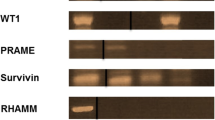Abstract
The knowledge of tumor-associated T-cell epitopes is important for the understanding of tumor biology and the development of cancer vaccines. We describe here a biochemical approach for the identification of tumor-associated T-cell epitopes. Peptides are extracted from immunoaffinity isolated MHC class I molecules of tumor cells and separated by HPLC. The HPLC fractions are then tested for biological activity of the peptides which are then sequenced by mass spectrometry. The tumor association of the identified T-cell epitopes is confirmed using synthetic analogs and T-cells of cancer patients.
Similar content being viewed by others
References
Renkvist, N., Castelli, C., Robbins, P. F., and Parmiani, G. (2001) A listing of human tumor antigens recognized by T cells. Cancer Immunol. Immunother. 50, 3–15.
Schubert, U., Anton, L. C., Gibbs, J., et al. (2000) Rapid degradation of a large fraction of newly synthesized proteins by proteasomes. Nature 404, 770–774.
Lengauer, C., Kinzler, K. W., and Vogelstein, B. (1998) Genetic instabilities in human cancers. Nature 396, 643–649.
Wagner, K., Miliotis, T., Marko-Varga, G., Bischoff, R. and Unger, K. K. (2002) An automated on-line multidimensional HPLC system for protein and peptide mapping with integrated sample preparation. Anal. Chem. 74, 809–820.
Chaurand, P., Luetzenkirchen, F., and Spengler, B. (1999). Peptide and protein identification by Matrix-Assisted Laser Desorption Ionisation (MALDI) and MALDI-Post-Source Decay Time-of-Flight mass spectrometry. J. Am. Soc. Mass Spectrom. 10, 91–100.
Yergey, A. L., Coorssen, J. R., Backlund, P. S. Jr., et al. (2002) De novo sequencing of peptides using MALDI/TOF-TOF. J. Am. Soc. Mass. Spectrom. 13, 784–791.
Medzihradszky, K. F., Campbell, J. M., Baldwin, M. A., et al. (2000) The characteristics of peptide collision-induced dissociation using a high-performance MALDI-TOF/TOF tandem mass spectrometer. Anal. Chem. 72, 552–558.
Mascher, B., Schlenke, P., and Seyfarth, M. (1999) Expression and kinetics of cytokines determinated by intracellular staining using flow cytometry. J. Immunol. Methods 223, 115–121.
Author information
Authors and Affiliations
Corresponding author
Rights and permissions
About this article
Cite this article
Demine, R., Sherev, T. & Walden, P. Biochemical determination of natural tumor-associated T-cell epitopes. Mol Biotechnol 25, 71–77 (2003). https://doi.org/10.1385/MB:25:1:71
Issue Date:
DOI: https://doi.org/10.1385/MB:25:1:71




